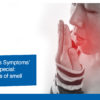Intracranial complications related to symptoms of sinus infections
In some cases, partially treated or untreated symptoms of sinus infections may cause various intracranial complications, such as meningitis, superior sagittal sinus thrombosis (SSST), intracerebral abscess, subdural empyema, epidural abscess and osteomyelitis. The frontal sinus infections are the main cause of intracranial disorders, followed by infections originating in the ethmoid, maxillary and sphenoid sinuses. Both acute stage of chronic sinusitis and acute sinusitis may result in intracranial problems, especially in adolescent male patients. If fever of an adolescent patient suffering from frontal sinusitis is not reducing and pain is not relieved within two days of starting the therapy, it implies that the intracranial problems have developed.
During intracranial complications, retrograde thrombophlebitis spreads the infection through Breschet’s veins, the diploic veins without valves. The diploic veins enable free flow between the sinuses and cranial periosteum, orbital and dural veins. The cortical and dural veins travel to the sagittal sinus, offering a direct channel for the movement of septic thrombi between the sinuses and brain parenchyma.
Although the complications related to symptoms of sinus infections are lethal, but with the invention of antibiotics, incidences of intracranial problems have reduced substantially. A successful treatment requires a multi-disciplinary approach. Services of neurosurgeons are needed. A surgical process done at right time will resolve both sinus infection and related intracranial problems. If ocular symptoms, particularly those reducing vision of the patient, increase, a quick surgery is necessary.
Antibiotics are administered intravenously to ensure that medicine reaches the affected area. Initially, a combination of penicillin that is resistant to penicillinase and other antimicrobial agents is given to the patients. In fact, results of the culture of the affected area determine the most suitable antibiotic. Although steroids are a controversial treatment, these are used if the brain edema is severe. Seizures occur in about 80% of intracranial complications, thus anticonvulsant drugs are required.
For diagnosis, a high-resolution computed tomography (CT) scan of the sinuses, orbit and brain is required, but initial level pathology may not be clear in the scan and the sinus scan documents may not be accurate. Thus, the CT scan report should be studied with the report of a clinical examination while selecting the suitable therapy. Alternatively, a MRI scan can be used as it identifies the problem earlier than a CT scan and accurately. In some cases, additional image analysis is also required to assess the amount of infection and decide the time for surgery.







